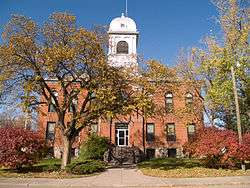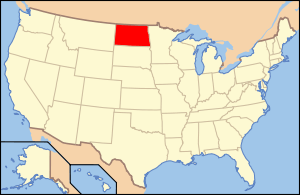Eddy County, North Dakota
| Eddy County, North Dakota | |
|---|---|
 | |
 Location in the U.S. state of North Dakota | |
 North Dakota's location in the U.S. | |
| Founded | April 27, 1885 |
| Seat | New Rockford |
| Largest city | New Rockford |
| Area | |
| • Total | 644 sq mi (1,668 km2) |
| • Land | 630 sq mi (1,632 km2) |
| • Water | 14 sq mi (36 km2), 2.2% |
| Population (est.) | |
| • (2015) | 2,365 |
| • Density | 3.8/sq mi (1/km²) |
| Congressional district | At-large |
| Time zone | Central: UTC-6/-5 |
| Website | Eddy County, North Dakota |
Eddy County is a county located in the U.S. state of North Dakota. As of the 2010 census, the population was 2,385.[1] Its county seat is New Rockford.[2] Eddy County was created by the 1885 territorial legislature from the northern half of Foster County and named for Ezra B. Eddy, a Fargo banker who had died a few weeks earlier. The county government was first organized on April 27, 1885.[3][4]
History
Eddy County was formed in 1885 from a portion of Foster County.[5] It was named after Ezra B. Eddy, one of the first bankers of the region in Fargo.
Geography
According to the U.S. Census Bureau, the county has a total area of 644 square miles (1,670 km2), of which 630 square miles (1,600 km2) is land and 14 square miles (36 km2) (2.2%) is water.[6] It is the smallest county in North Dakota by area.
Adjacent counties
- Benson County (north)
- Nelson County (northeast)
- Griggs County (southeast)
- Foster County (south)
- Wells County (west)
Major highways
County Roads
- Eddy County Road 1
- Eddy County Road 2
- Eddy County Road 3
- Eddy County Road 4
- Eddy County Road 5
- Eddy County Road 6
- Eddy County Road 7
- Eddy County Road 8
- Eddy County Road 9
- Eddy County Road 10
- Eddy County Road 12
- Eddy County Road 14
- Eddy County Road 16
Eddy County Road 14 is a north-south County Road in North Dakota. It runs from North Dakota Highway 15 near New Rockford, North Dakota to Eddy County Road 9 (1st Ave North) in downtown New Rockford.
Eddy County Road 9 is an East-West County Road in North Dakota. It runs from US 281/North Dakota Highway 15 (1st Street) in New Rockford, North Dakota to Wells County CR 2 near New Rockford.
National protected area
Demographics
| Historical population | |||
|---|---|---|---|
| Census | Pop. | %± | |
| 1890 | 1,377 | — | |
| 1900 | 3,330 | 141.8% | |
| 1910 | 4,800 | 44.1% | |
| 1920 | 6,493 | 35.3% | |
| 1930 | 6,346 | −2.3% | |
| 1940 | 5,741 | −9.5% | |
| 1950 | 5,372 | −6.4% | |
| 1960 | 4,936 | −8.1% | |
| 1970 | 4,103 | −16.9% | |
| 1980 | 3,554 | −13.4% | |
| 1990 | 2,951 | −17.0% | |
| 2000 | 2,757 | −6.6% | |
| 2010 | 2,385 | −13.5% | |
| Est. 2015 | 2,365 | [7] | −0.8% |
| U.S. Decennial Census[8] 1790-1960[9] 1900-1990[10] 1990-2000[11] 2010-2015[1] | |||
2000 census
As of the census of 2000, there were 2,757 people, 1,164 households, and 743 families residing in the county. The population density was 4 people per square mile (2/km²). There were 1,418 housing units at an average density of 2 per square mile (1/km²). The racial makeup of the county was 96.37% White, 0.07% Black or African American, 2.36% Native American, 0.15% Asian, 0.07% Pacific Islander, 0.25% from other races, and 0.73% from two or more races. 0.62% of the population were Hispanic or Latino of any race. 44.1% were of Norwegian and 32.5% German ancestry.
There were 1,164 households out of which 27.70% had children under the age of 18 living with them, 56.40% were married couples living together, 5.00% had a female householder with no husband present, and 36.10% were non-families. 34.20% of all households were made up of individuals and 20.40% had someone living alone who was 65 years of age or older. The average household size was 2.30 and the average family size was 2.96.
In the county the population was spread out with 23.60% under the age of 18, 6.10% from 18 to 24, 22.50% from 25 to 44, 23.10% from 45 to 64, and 24.70% who were 65 years of age or older. The median age was 44 years. For every 100 females there were 95.50 males. For every 100 females age 18 and over, there were 92.30 males.
The median income for a household in the county was $28,642, and the median income for a family was $37,625. Males had a median income of $24,063 versus $20,344 for females. The per capita income for the county was $15,941. About 6.90% of families and 9.70% of the population were below the poverty line, including 11.50% of those under age 18 and 11.00% of those age 65 or over.
2010 census
As of the 2010 United States Census, there were 2,385 people, 1,057 households, and 653 families residing in the county.[12] The population density was 3.8 inhabitants per square mile (1.5/km2). There were 1,323 housing units at an average density of 2.1 per square mile (0.81/km2).[13] The racial makeup of the county was 95.2% white, 2.4% American Indian, 0.3% Asian, 0.2% black or African American, 0.1% Pacific islander, 0.8% from other races, and 1.0% from two or more races. Those of Hispanic or Latino origin made up 2.2% of the population.[12] In terms of ancestry, 52.7% were German, 45.9% were Norwegian, 9.3% were Irish, 6.5% were Swedish, and 1.3% were American.[14]
Of the 1,057 households, 24.2% had children under the age of 18 living with them, 50.9% were married couples living together, 7.4% had a female householder with no husband present, 38.2% were non-families, and 33.9% of all households were made up of individuals. The average household size was 2.18 and the average family size was 2.77. The median age was 49.2 years.[12]
The median income for a household in the county was $38,404 and the median income for a family was $47,857. Males had a median income of $31,887 versus $28,194 for females. The per capita income for the county was $20,302. About 11.5% of families and 15.4% of the population were below the poverty line, including 21.0% of those under age 18 and 21.7% of those age 65 or over.[15]
Communities
Cities
- New Rockford (county seat)
- Sheyenne
Townships
- Bush
- Cherry Lake
- Columbia
- Colvin
- Eddy
- Freeborn
- Gates
- Grandfield
- Hillsdale
- Lake Washington
- Munster
- New Rockford
- Paradise
- Pleasant Prairie
- Rosefield
- Sheldon
- Superior
- Tiffany
Unincorporated community
- Brantford
See also
References
- 1 2 "State & County QuickFacts". United States Census Bureau. Retrieved October 31, 2013.
- ↑ "Find a County". National Association of Counties. Retrieved 2011-06-07.
- ↑ "County History". Official Portal for North Dakota State Government. Retrieved 4 May 2011.
- ↑ "Dakota Territory, South Dakota, and North Dakota: Individual County Chronologies". Dakota Territory Atlas of Historical County Boundaries. The Newberry Library. 2006. Retrieved February 3, 2015.
- ↑ "Eddy County (Carrington, North Dakota History Web Page)".
- ↑ "2010 Census Gazetteer Files". United States Census Bureau. August 22, 2012. Retrieved January 28, 2015.
- ↑ "County Totals Dataset: Population, Population Change and Estimated Components of Population Change: April 1, 2010 to July 1, 2015". Retrieved July 2, 2016.
- ↑ "U.S. Decennial Census". United States Census Bureau. Retrieved January 28, 2015.
- ↑ "Historical Census Browser". University of Virginia Library. Retrieved January 28, 2015.
- ↑ Forstall, Richard L., ed. (March 27, 1995). "Population of Counties by Decennial Census: 1900 to 1990". United States Census Bureau. Retrieved January 28, 2015.
- ↑ "Census 2000 PHC-T-4. Ranking Tables for Counties: 1990 and 2000" (PDF). United States Census Bureau. April 2, 2001. Retrieved January 28, 2015.
- 1 2 3 "DP-1 Profile of General Population and Housing Characteristics: 2010 Demographic Profile Data". United States Census Bureau. Retrieved 2016-03-14.
- ↑ "Population, Housing Units, Area, and Density: 2010 - County". United States Census Bureau. Retrieved 2016-03-14.
- ↑ "DP02 SELECTED SOCIAL CHARACTERISTICS IN THE UNITED STATES – 2006-2010 American Community Survey 5-Year Estimates". United States Census Bureau. Retrieved 2016-03-14.
- ↑ "DP03 SELECTED ECONOMIC CHARACTERISTICS – 2006-2010 American Community Survey 5-Year Estimates". United States Census Bureau. Retrieved 2016-03-14.
External links
 |
Benson County | Nelson County |  | |
| Wells County | |
|||
| ||||
| | ||||
| Foster County | Griggs County |
Coordinates: 47°43′N 98°54′W / 47.72°N 98.90°W